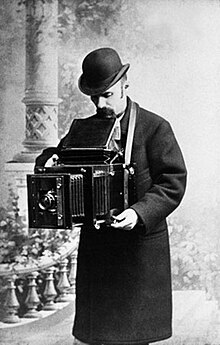Karl Bulla

Carl Oswald Bulla or Karl Karlovich Bulla (Russian: Карл Карлович Булла; 26 February 1855[1] or 1853[2] – 28 November 1929) was a German-Russian photographer, often referred to as the "father of Russian photo-reporting".[3]
Biography
Carl Oswald Bulla was born in Leobschütz in
After arriving in St. Petersburg, Bulla started to work as a delivery-boy in the firm Dupant that made and sold photography supplies. Soon his responsibilities included handmaking (coating and sensitizing) of the photographic glass negative plates. At the age of twenty Bulla opened a small factory producing "momentary dry bromine-gelatin plates". Buying the readymade photographic materials was much more convenient than handmaking their own and soon Bulla's plates became popular, selling not only in St.Petersburg but across the whole Russian Empire.[1] In February 1876 Bulla requested his naturalization and in July 1876 became a subject of the Russian Empire.[1]
In 1875 Bulla opened his first photographic studio at 61
At the end of the 19th century, newspaper printing technology allowed the publishing of photographs. In 1894 Russian Department of Post and Telegraphs also allowed the use of postcards. Both events significantly increased the demand for photographs.[1] In 1895 Bulla stopped his production of photographic supplies[1] and put all his energy into photography. In his advertisement, he wrote "The oldest photographer-illustrator Karl Bulla photographs for the illustrated magazines anything and anywhere without limits from the landscape or the building, indoor or outdoor day or night at the artificial light".[2]
Indeed, he photographed everything and anything: Life of Tsar family and assemblies of anti-government
In 1916 Bulla passed the management of the firm "Bulla and sons" to his sons Alexander and Viktor and moved to Ösel Island (currently Saaremaa, Estonia). He lived a quiet life there, photographing the local ethnographic material and teaching Estonian boys the basics of photography until his death in 1929.[1]
The sons

After the retirement of Karl Bulla, his firm was managed by his sons, Alexander and Viktor. Viktor Bulla was a notable photo-reporter in his own right. He was the author of a series on the Russo-Japanese War and World War I.[3] At that time, before the invention of the telephoto lens, photography was a very difficult and dangerous mission.[3]
Later Viktor Bulla made photographs of the
The life of Andrey Bulla also ended tragically. He was arrested in the early 1930s and sent to
Archive
In 1935 the son of Karl, Viktor Bulla donated to the
In 2003 there was a large exhibition of Bulla's prints celebrating 300 years of Saint-Petersburg and 150th birthday of Karl Bulla (by the 1853 version).[5] People of Saint-Petersburg put a bronze sculpture of Karl Bulla on Malaya Sadovaya Street near the former studio of Karl Bulla. The sculpture shows a photographer with an ancient camera and an umbrella photographing a bulldog.[6]
Some works
-
Trams on the frozenNeva River
-
Street scene
-
Stonemasons, 1900s
-
Grigory Rasputin, Major-General Putyatin and Colonel Lotman, 1904
-
Collapse of the Egyptian Bridge
-
Leonid Andreyev and his wife, Anna
-
Deputies of the disbanded State Duma arrive to Vyborg to sign an anti-government Vyborg Manifesto, 1906
-
1900s
-
1900s
-
Homeless Shelter, 1910
-
Ilya Yefimovich Repin reads the announcement of Leo Tolstoy death. Present Korney Chukovskyand Nordman-Severova (Repin's wife).
-
Opening of the Hercules club, 1912
-
Kazan Cathedral House. Nevsky Prospect, 25. Celebrating the 300th anniversary of the Romanov dynasty. 1913
-
Feodor Chaliapin and his friends ice skating, 1914
-
Apraksin Dvor on fire, July, 1914
-
Russian Vityaz, 1915
-
Alexandra Fyodorvna arrive to Stavka, May 1916
References
- ^ a b c d e f g h i j k Karl Karlovich Bulla in Encyclopedia Peoples.ru (in Russian)
- ^ a b c d Karl Bulla and Sons Archived 2007-06-13 at the Wayback Machine article on Artproject.ru (in Russian)
- ^ a b c d e f Karl Bulla: The Father of Russian Photo-reporting Archived 2012-02-07 at archive.today "Глаза и уши Петербурга", 2004
- ^ "Gay Camp, Old Russian Style". Archived from the original on 2010-07-11. Retrieved 2007-05-18.
- ^ Karl Bulla:Classic of the National Photography Museum.ru (in Russian)
- ^ Memorial to a photographer Archived 2009-11-12 at the Wayback Machine with photographs of the memorial (in Russian)
Further reading
- Polikarpova, Galina (2003). "Carl Bulla (1853–1929)". St. Petersburg in Focus: Photographers of the Turn of the Century. By Petrova, Evgenija N. Palace. pp. 17–20. ISBN 978-5-93332-114-9.



















